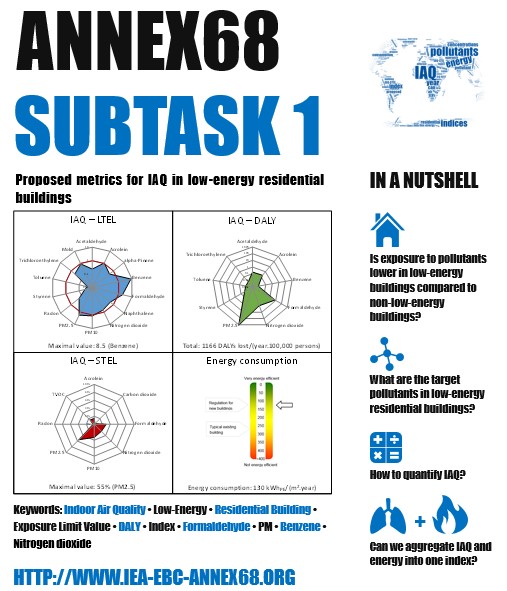Definition
The lack of an index (or a marker or a metric), which quantitatively describes the IAQ and allows its evaluation against the indices describing energy use, can be regarded as one of the major obstacles for achieving the further and closer integration of energy and IAQ strategies in building design and optimization. Such an index/metric would allow examination of different strategies for achieving high IAQ in relation to their energy performance and greenhouse gas emissions.
One important complication of developing such index is that hundreds of chemical and biological pollutants are found in indoor air, including residential environments, and there is no consensus on which compound could serve the purpose of such index, or how to integrate these compounds into one index or how such an index could be developed based on the available information on the effects of pollutants on humans; for many of pollutants such information is still lacking.
The goal of Subtask 1 was setting up the metrics to assess the performance of low-energy buildings as regards indoor air quality combining the aspirations to achieve very high energy performance without compromising indoor environmental quality.
Subtask 1 followed the subsequent steps:
- Collection of data on indoor air pollution in residential buildings with a particular focus on low-energy buildings to provide an overview of the exposure of occupants to contaminants in residential buildings and to identify differences, if any, between low-energy buildings and the buildings that cannot be termed as low-energy (representative of the current building stock).
- Compilation of the pollutant Exposure Limit Values relevant for the current project.
- Identification of target pollutants relative to indoor air quality.
- Surveying IAQ indices developed previously.
- Defining the metric(s) that can be used to achieve the objectives of Annex 68 project considering the aspect of energy consumption.

A summary of the Subtask 1 accomplishments
- Subtask 1 conducted a literature review to compare IAQ in low-energy buildings compare to older ones.
- Subtask 1 reviewed previous priorization schemes to select the pollutants to be considering when dealing with IAQ in low-energy buildings.
- Subtask 1 conducted a review of IAQ indicators, classified them according to the definition of their sub-indices and clarified the aggregation problematic.
- Subtask 1 defined a new graphical representation of IAQ along with energy consumption for low-energy buildings.
- Subtask 1 developed a Microsoft Excel spreadsheet to calculate the IAQ sub-indices defined during the Annex68 project.
Unresolved technical issues
Due to current scientific knowledge and also short time for this subtask, Subtask 1 did not achieve to properly aggregate energy and IAQ. Instead, Subtask 1 has to consider energy consumption (evaluated in primary energy consumption) separately from the IAQ indices. A prerequisite to aggregate energy and IAQ indices is that both are measured on the same absolute scale, which they are not. Monetizing the effects of IAQ and energy could be a way to bring both indices to the same scale but many questions remain before it can become standard practice. Even if such an approach could be used for a limited number of pollutants, there was too little data to extend this approach to all the pollutants listed in this study.
Recommendations for follow-up work
The following recommendations for future work rely upon the results obtained in Subtask 1.
- Subtask 1 developed a set of indices that have not been used intensively yet. Some examples have been treated in Subtask 4 to evaluate the IAQ of dwellings or to compare ventilation system efficiency but it is not enough. Additional studies have to be done to consolidate the benefit of calculating such indices, to understand the meaning behind the used scale through practical examples and to evaluate the sensitivity of such a tool, for example, to evaluate the energy retrofit of a building in terms of IAQ.
- Aggregating IAQ and energy is an obvious follow-up work as most actions to reduce the concentration of pollutants in indoor spaces require use of energy, such as increasing the rate of ventilation with outdoor air, use of air cleaners, or local exhaust hoods.
- In addition to health, other factors such as comfort, productivity, user friendliness, durability… should be also considered and aggregated indices should be defined accordingly.
- Subtask 1 defined a set of indices based on long (1year) and shorter (8h-24h) time periods. With the development of IoT and access to pollutant concentration in real time, there’s a now need to develop real time IAQ indices to control ventilation/filtration equipment and/or to inform occupants of buildings about IAQ remediations.
The two last recommendations are addressed in the currently prepared IEA EBC Annex 86 - Energy Efficient IAQ Management in Residential Buildings.
Deliverables
M.O. Abadie, P. Wargocki, CR 17: Indoor Air Quality Design and Control in Low-energy Residential Buildings- Annex 68 – Subtask 1: Defining the metrics – In the search of indices to evaluate the Indoor Air Quality of low-energy residential buildings, 116 p, 2017.
https://www.aivc.org/sites/default/files/AIVC_CR17_0.pdf